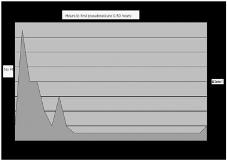ONSET LATENCY OF PSEUDOSEIZURES DURING VIDEO EEG MONITORING
Abstract number :
1.380
Submission category :
Year :
2004
Submission ID :
4408
Source :
www.aesnet.org
Presentation date :
12/2/2004 12:00:00 AM
Published date :
Dec 1, 2004, 06:00 AM
Authors :
Sanjiv K. Sahoo, Howard P. Goodkin, and Nathan B. Fountain
Pseudoseizures are sudden alterations in behaviour including motor, sensory, or consciousness unaccompanied by abnormal electrical discharges in the brain. Inpatient video EEG monitoring can be quite useful in differentiating these events from epileptic seizures. Previous studies (1, 2) have demonstrated that the latency to the first pseudoseizure is typically less than 24 hours following admission. We looked at the latency to the first pseudoseizure for patients admitted to the University of Virginia during the years 2000-2004, inclusive. We were interested in determining whether our experience with the time to the first pseudoseizure is similar to that previously described and to determine if the semiology of pseudoseizures with latency longer than 24 hours is different from those with a shorter latency. Video-EEG monitoring reports for the years 2000-2004, inclusive, were retrospectively searched for the terms [lsquo]pseudoseizure[rsquo], [lsquo]nonepileptic[rsquo], and [lsquo]psychogenic[rsquo]. This search yielded names of 117 patients. The monitoring reports and video-EEG records of these patients were subsequently reviewed.
40 patients with physiologic nonepileptic movements, concomitant epileptic seizures, auras with preserved awareness, a diagnosed neurological abnormality, or age [lt]12 years were excluded.
The remaining 77 patients form the basis of this study. Epidemiologic data, latency to the first pseudoseizure, number of nonepileptic events, duration of stay, and clinical semiology were analyzed. Of the 77 patient records reviewed, 80% were women and 60% were between 20-45 years of age with an average age of 36 years. Average duration of admission was 2.3 days (range 1-7 days) with 4.5 pseudoseizures recorded per admission. The average latency to first spell was 10 hrs or 0.4 days (range 1-51 hours). 53% of patients had their first pseudoseizure within 4 hours, 68% within 8 hours, 83% within 1 day and 94% within 2 days.
55/65 patients with events occurring during the first 24 hours had motor manifestations characterized by movements such as thrashing or nonrhythmic jerking of the extremities, head shaking, pelvic thrusting, or bicycling in the presence or absence of altered awareness. In contrast, 7/12 (58%) of the patients who had events after 1 day had atypical semiology which included dysesthesias, immobility, dissociation, tinnitus, jaw tightening, back arching and staring.[figure1] 83 % of our pseudoseizure patients had their first event within 1 day and 94% within 2 days. This suggests that patients with nonepileptic pseudoseizures usually have events within 2 days of video EEG monitoring. Those with event onsets greater than 1 day (58% of these patients) are more likely to have atypical semiology. Those without events in 2 days warrant reconsideration of the diagnosis.
References:
1) Epilepsia 2003, 44 Suppl. 9:12 (abst. 1.025)
2) Epilepsia Aug;1998, 39(8):863-7
